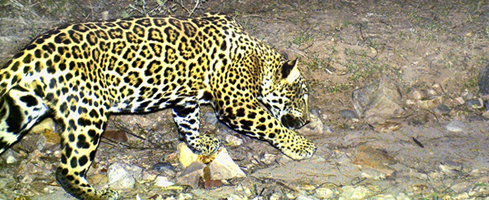Viviendo con Felinos

When a rural landowner participating in NJP’s Viviendo con Felinos project produces a photograph of a jaguar on his ranch, he’ll be paid a cash value equal to the long-standing bounty offered locally for dead jaguars. And since that same jaguar – kept alive – could be photographed numerous times, it makes sense that living wildlife is more valuable. While the jaguar is the grand prize of Viviendo con Felinos, the rancher will also receive stepped down awards for photographs of ocelots, mountain lions, and bobcats. This innovative program begins by awarding ranchers for the presence of living wildlife, especially large carnivores.
Twelve ranch owners near the reserve are enrolled in the project and have signed agreements not to harm wildlife. Their land encompasses a total of 55,000 acres, effectively increasing the protected area where predators can roam free from harm.
 Viviendo con Felinos succeeds at addressing our highest priorities: to immediately reduce jaguar mortality, to develop trusting relationships and encourage a conservation ethic among rural landowners, and to gain better scientific understanding of the jaguar population. With the assistance of a field technician devoted to the project, we are placing motion-triggered cameras in known wildlife corridors on participating ranches to increase wild cat sightings.
Viviendo con Felinos succeeds at addressing our highest priorities: to immediately reduce jaguar mortality, to develop trusting relationships and encourage a conservation ethic among rural landowners, and to gain better scientific understanding of the jaguar population. With the assistance of a field technician devoted to the project, we are placing motion-triggered cameras in known wildlife corridors on participating ranches to increase wild cat sightings.
Now in its ninth year, the project has compensated ranchers for hundreds of feline photographs. It is the best way we can envision to build local tolerance for jaguars and minimize human-wildlife conflicts. We will continue to approach candidate ranches that have expressed an interest in the project.
 Meanwhile, landowners are beginning to recognize the value of the natural communities they inhabit and are slowly shifting attitudes to favor conservation. As we work in tandem with the local ranching community, our outreach has stressed the importance of protecting patches of native vegetation from the pressures of livestock grazing and to restore habitat, using the Northern Jaguar Reserve as a model. They are learning through firsthand experience that carnivore-friendly range management can be done in a sustainable way through pasture rotation, protective husbandry, water harvesting, gabion construction, and cattle-exclusion zones in sensitive riparian habitat.
Meanwhile, landowners are beginning to recognize the value of the natural communities they inhabit and are slowly shifting attitudes to favor conservation. As we work in tandem with the local ranching community, our outreach has stressed the importance of protecting patches of native vegetation from the pressures of livestock grazing and to restore habitat, using the Northern Jaguar Reserve as a model. They are learning through firsthand experience that carnivore-friendly range management can be done in a sustainable way through pasture rotation, protective husbandry, water harvesting, gabion construction, and cattle-exclusion zones in sensitive riparian habitat.
Ranchers are also seeing that improved ranch management can help to reduce livestock predation. We’ve initiated a method for registering cattle deaths and have had few predation reports since. Records are being kept to help further understand the dynamics of cattle predation, ranch economics, wildlife presence, and how these factor into jaguar poaching as a form of rancher retaliation and control.

